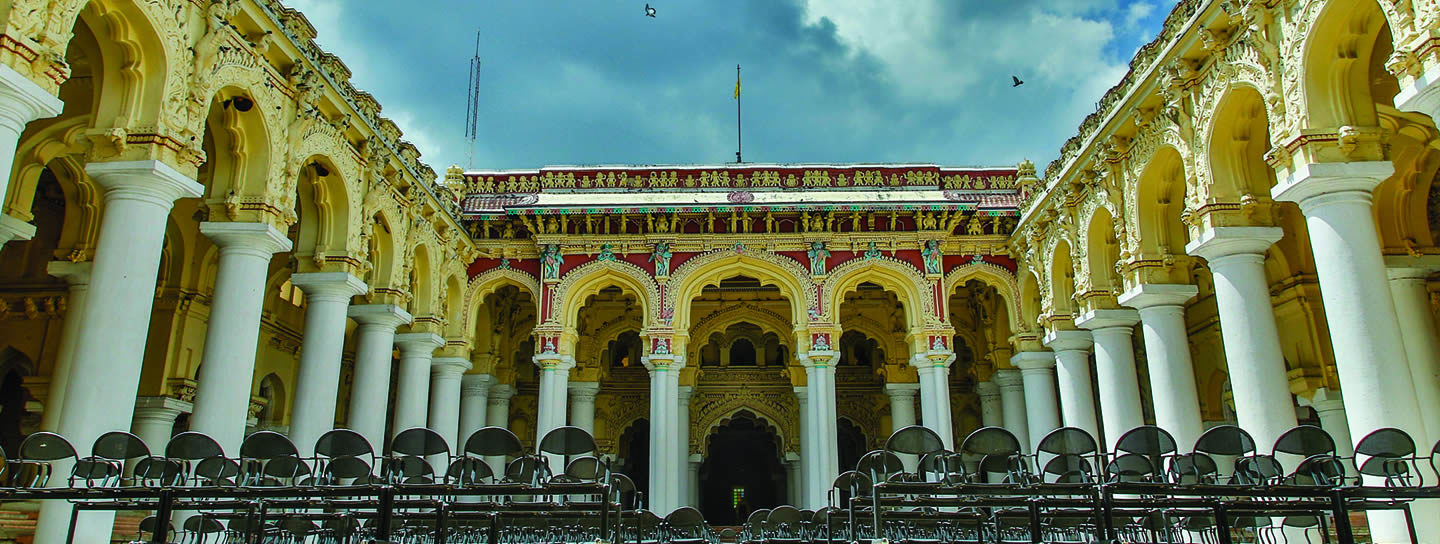Other Places of Interest
There are a number of temples in Madurai that see pilgrims coming for worship. Also the city has a palace built by the Nayaka kings and a number of mosques, tombs and churches worth a visit.
Kudal Alagar Perumal Temple
This is the most important shrine to Lord Vishnu in the city and it is one of the 108 Divya Desam temples of Vishnu. Built by the Nayaka kings in the 17th century, the entrance is through a high gopura gateway in the east. Inside there is a beautiful colonnaded corridor with the pillars carved with the mythical yali, a lion image. The main shrine has three sanctums placed one above the other that have a sitting, a standing and a reclining image of Vishnu. There is a separate shrine to Goddess Lakshmi in another courtyard, here she is called Maduravalli Naachiyar.
Thirupparan Kundram Murugan Temple
Lord Murugan or Kartikeya is the son of Shiva and Parvati and is very popular in Tamil Nadu. There are six shrines dedicated to him called the ‘Six Abodes of Murugan’ and this is one of them. Built in 1505 CE the temple is carved out of a rock and is a beautiful example of the art of the stone carver in the Nayaka period. It is said that Murugan married Devasena the daughter of Lord Indra here. As the commander-in-chief of the army of the gods Murugan’s image leads the wedding procession of Sundareswarar and Meenakshi during the Chathirai Festival.
Pazhamudhir Solai
This temple is also one of the Six Abodes of Lord Murugan who is also called Kartikeya, Skanda and Subramanya. He is believed to be the son of Meenakshi and Sundareswarar and was born in Madurai. The temple stands on a hill near the complex of Vishnu shrines of Alagar Koil that is 16 km from Madurai.
The Nayaka Palace
This palace of the Nayaka dynasty that ruled Madurai in the 17th and 18th century was mostly build by Tirumala Nayaka who is also credited with building much of the Meenakshi Amman Temple. At one time it must have been a large complex but today only a small part has survived as the boundary areas were demolished by the British. With pillars and ceilings covered in carvings and plaster decorations the palace has a royal and ornate style.
Mosques & Tombs
For a few decades in the 14th century Madurai was ruled by sultans before the kings of Vijayanagar conquered the kingdom and established the Nayakas as governors. The main mosque of the city is the Kazimir Mosque. There are the tombs of Sultan Alauddin and Sultan Shamsuddin placed in a small compound. Nearby are the Alauddin Mosque with tapering octagonal minarets and the tomb of a Sufi saint Bara Mastan Sada.
Anglican Cathedral
Once the English East India Company built the city of Madras (modern Chennai) they also occupied Madurai and turned it into a trading post. The cathedral was built in 1881 in a Spartan neo-Gothic style by the English architect Chisholm who also built many buildings in Madras.
Gandhi Museum
This museum is dedicated to Mahatma Gandhi and displays many items used by him. There is an interesting exhibition that explains the history of the freedom movement that was led by Gandhiji.
Mariamman Teppakulam Tank
This is a huge tank where the Thepporstoram or the Float Festival is held when images of Meenakshi Amman and Lord Sundareswarar are taken out on a ceremonial boat ride. The tank is fed from the Vaigai River and never dries up. While the tank was being excavated a huge image of Lord Ganesh was discovered and the image is now installed within the Meenakshi Amman Temple complex.
Alagarkoil
This complex of Vishnu shrines stands on a hill 12 km north of Madurai. The deity in the sanctum is called Kallalagar and he is considered as the brother of Meenakshi Amman. So during the Chithirai festival the deity is an important participant in the marriage ceremony of Goddess Meenakshi and Lord Sundareswarar. The main shrine is a rare example of the 12th century Pandyan architecture with murals painted on the ceilings and ancient carvings on walls and pillars. The shrine courtyard is surrounded by colonnaded corridors.
Samanar Hills
This ancient rock built complex was once the monastery where Tamil Jain monks lived and meditated. There are exquisitely beautiful carvings of Jain saints, the Tirthankaras including Lord Vardhaman Mahavir carved on the rock face. Historians date some of the sculptures to the 9th century BCE.


